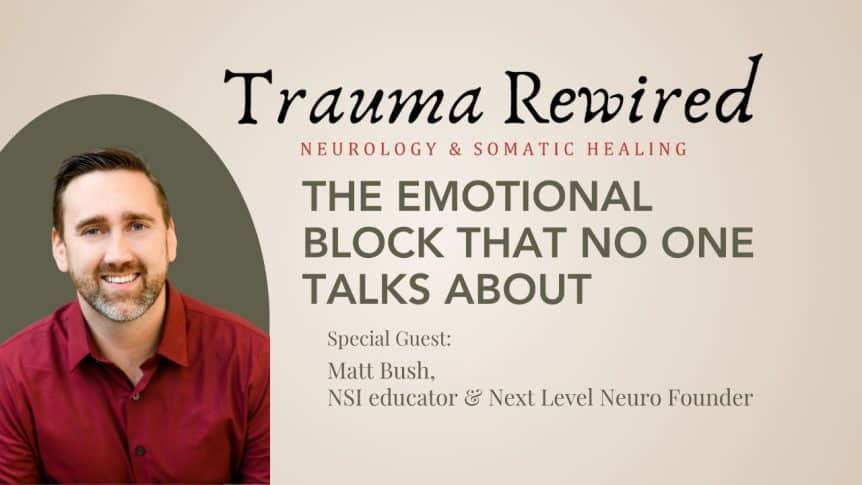
Have you ever drawn a blank when asked how you’re feeling? Or maybe you experience constant inner buzzing, numbness, or anxiety without any words to describe it. You’re not broken—and you’re not alone.
In this deeply informative and compassionately nuanced episode, we are joined with guest Matt Bush to unpack alexithymia: a common and often misunderstood trauma-related trait that involves difficulty identifying, describing, or connecting with emotions.
More than emotional “numbness,” alexithymia involves disrupted communication between the body and brain, making healing feel elusive. We break down the neurological roots of this trait, how it differs from emotional numbing in PTSD, and why traditional talk therapy often isn’t enough. You’ll learn how interoceptive training—like what’s taught in NeuroSomatic Intelligence (NSI)—can help bring emotional awareness back online.
Whether you’re a practitioner, trauma survivor, or someone just feeling disconnected, this conversation offers hope and concrete tools to rewire the nervous system for emotional clarity, embodiment, and relational healing.
Timestamps:
- 0:43 – What Is Alexithymia?
- 3:00 – Why It’s Common After Trauma
- 4:40 – The TAS-20 Scale: 3 Key Features
- 7:00 – Lived Experience + Relationship Impact
- 10:00 – Alexithymia vs. Emotional Numbing
- 14:40 – Trauma’s Impact on Emotional Mapping
- 17:00 – Neurological Underpinnings (Insula, DMN, etc.)
- 20:00 – Substance Use, Shutdowns & Coping
- 26:00 – Functional Freeze & Stress Sensitivity
- 30:00 – How Neuroplasticity Supports Change
- 33:00 – NSI Tools for Rewiring Emotional Awareness
- 36:00 – Practical Steps to Start Feeling More
- 40:00 – Emotional Expression, Relationships & Health Outcomes
Key Takeaways:
- Alexithymia is not a disorder but a trainable trait, often shaped by trauma and nervous system adaptations.
- Traditional talk therapy may not fully address alexithymia due to its neurological roots—interoceptive training is key.
- It differs from emotional numbing in PTSD; each involves distinct brain networks (e.g., DMN vs. salience network).
- Emotional awareness isn’t just about language—it starts with sensing the body.
- Healing emotional disconnect can improve not just mental health, but physical health and relational dynamics.
Resources Mentioned:
- NeuroSomatic Intelligence Coaching Certification → www.neurosomaticintelligence.com
- Toronto Alexithymia Scale (TAS-20)
- Referenced Studies:
- Vandervoort Meta-analysis (2013)
- Journal of Global Health Reports (2025)
- Gharlic & Doba (2015)
- Brewer & Kuehnerberg (2016)
- PTSD + Alexithymia Therapy Outcomes (2008)
If this episode gave you clarity, comfort, or tools for your healing, share it with someone who needs it.
Don’t forget to subscribe on your favorite audio platform or hit the bell on YouTube so you never miss an episode.
Transcript available on Apple Podcasts
👉 Want to learn how to rewire your nervous system and support others in doing the same? Explore the NeuroSomatic Intelligence Certification
Healing is possible—and it starts with knowing how to listen to your body.